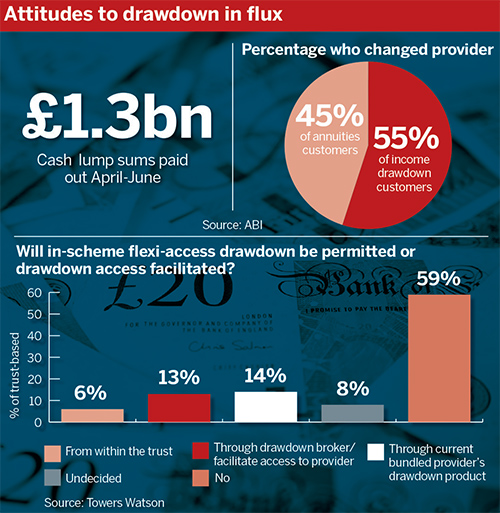More than half of the £2.5bn withdrawn by pension savers in the three months since April has been paid out in cash lump sums, but experts predict consumers will shift their focus towards more sophisticated products.
Taking cash in lump sums has proved to be a popular option since the introduction of the freedoms, but many experts have said consumer behaviour will continue to change as defined contribution pot sizes grow.
We don’t yet have a position where [all of the] companies that are going to make drawdown available have done so
David Bird, LifeSight
Data from the Association of British Insurers this week showed £1.3bn has been paid in cash lump sums, averaging just under £15,000 in size. A further £1.1bn has been paid out via 264,000 income drawdown payments, averaging close to £4,200.
Despite this, Saq Hussain, head of DC for the North at consultancy PwC, said lump sums may drop in popularity as pot sizes grow and other options become more appealing.

“As pot sizes get bigger I think you’ll see people want to do more than just take the cash,” he said.
Hussain added cash would likely continue to be popular until pot sizes reached the region of £30k-£40k.
Earlier this year, government-backed mastertrust Nest released a blueprint for a default retirement income strategy comprised of multiple income-generating vehicles over different phases of retirement, though the majority of the young fund’s members will not be affected materially by the recent reforms for some years.
Rise of DB flexibility
Hussain said market activity would calm down following the “initial splurge” of people cashing in small pots, but added a wave of defined benefit members looking to access the flexibility could follow.
“I’m seeing an increase in employers and trustees making the freedoms available to DB members,” he said.
Paul Bucksey, head of DC at asset manager BlackRock, said clients with DB schemes were increasingly looking to offer flexibility to members.
“There’s an emerging theme of DB members wanting to consider a [full or partial] transfer of their pension value,” he said, adding: “It’s a complex area. We do insist the individual takes advice. We are seeing that demand and momentum start to build.”
Pull of drawdown
ABI data showed £1.3bn has been invested in income drawdown products, with fund sizes averaging £68,000, while £990m has been invested in annuities, with funds invested averaging £55,600.
Customers buying an annuity changed provider in 45 per cent of cases while income drawdown purchasers changed provider in 55 per cent of cases, demonstrating a limited desire to shop around.
David Bird, head of proposition development at mastertrust LifeSight, operated by pension consultancy Towers Watson, said the market for retirement products needed to develop further.
“We don’t yet have a position where [all of the] companies that are going to make drawdown available have done so. We don’t have a situation where the advice process is set up properly,” he said.
Research published recently by Towers Watson supports this. Trust-based schemes responding to its Pension Flexibility Survey 2015 largely said they would not offer drawdown to members, with 59 per cent saying they would not facilitate it.
More than a quarter (27 per cent) of respondents said they would offer access to drawdown through a broker or provider and just 6 per cent said they would offer drawdown or flexi-access drawdown funds from within the scheme. A further 8 per cent were undecided.














